Smart lighting hacks to make your Creative Video Production stand out
Discovering the current Patterns in Video Production for 2025
As we come close to 2025, the video production landscape is poised for significant advancement, characterized by innovations in augmented fact and AI-driven editing and enhancing devices. The combination of interactive storytelling and immersive 360-degree experiences is redefining audience interaction, while lasting production techniques obtain prominence. Furthermore, enhanced online streaming capabilities are readied to equalize content accessibility like never ever previously. These developments increase necessary concerns concerning the future of creativity and modern technology in video production-- what effects will these trends hold for designers and consumers alike?
Enhanced Truth in Video Production
Enhanced fact (AR) is positioned to transform video production by flawlessly blending digital elements with live-action footage. This ingenious technology improves narration by providing immersive experiences that engage visitors on a deeper level. AR enables filmmakers to include interactive graphics, computer animations, and information overlays directly right into the real-world setting recorded on display, creating a vibrant viewing experience that traditional techniques can not accomplish.
In 2025, we can anticipate AR to become an integral component of various video production processes, from pre-production planning to post-production enhancements. The capacity to envision intricate scenes and components in real-time will enable directors and cinematographers to make educated choices during filming. Furthermore, AR can promote remote cooperation, enabling employee to interact with 3D designs and aesthetic effects from different places, consequently simplifying the production process.
Advertising and promotional methods will certainly benefit from AR assimilation, as brand names significantly take advantage of this technology to produce appealing and special material. As customer demand for interactive and cutting-edge experiences remains to expand, AR will play a vital role fit the future of video production, driving creative thinking and broadening the opportunities for filmmakers.
AI-Powered Modifying Tools
As the video production landscape evolves, AI-powered modifying tools are becoming a game changer. These devices use enhanced automation attributes that streamline process, facilitate real-time partnership amongst teams, and existing boosted interface for a more user-friendly editing and enhancing experience. Understanding these advancements is essential for experts looking for to stay competitive in the sector.
Boosted Automation Functions
The rise of AI-powered editing tools is established to transform the video production landscape, enhancing operations and improving imaginative opportunities. These enhanced automation attributes are made to reduce manual labor, enabling material designers to focus a lot more on narration and creative vision. By leveraging artificial intelligence algorithms, these tools can examine video, recognize vital moments, and suggest optimal cuts, considerably reducing modifying time.
One of one of the most amazing improvements is the capability of AI to comprehend and adapt to different editing designs. This capability makes it possible for editors to use specific appearances or genres to their tasks effectively, promoting an extra tailored technique. AI-driven color grading and audio editing devices can immediately improve audio and visual high quality, guaranteeing a professional surface without comprehensive manual changes.

Real-Time Collaboration Benefits
Real-time partnership is coming to be increasingly crucial in video production, particularly with the introduction of AI-powered modifying tools. These ingenious technologies allow several stakeholders, consisting of clients, supervisors, and editors, to collaborate seamlessly, no matter their physical areas. By helping with immediate comments and alterations, AI-powered systems boost the imaginative procedure, allowing teams to make choices rapidly and effectively.
One of the key benefits of real-time partnership is the capability to take advantage of AI for data-driven understandings. For instance, AI formulas can assess footage and recommend edits or changes that straighten with the task's vision, streamlining the workflow. This not just increases the editing and enhancing procedure however likewise ensures that creative choices are notified by historical information and market patterns.

Improved Interface
Innovative user interfaces in AI-powered editing and enhancing tools are changing the video production landscape by improving the user experience and simplifying workflows. These devices take advantage of progressed algorithms to streamline complicated editing tasks, permitting designers to concentrate much more on narration and creativity instead than technical ins and outs.
One vital improvement is the integration of user-friendly drag-and-drop performances, which enable individuals to construct their jobs flawlessly. Combined with real-time comments systems, editors can imagine adjustments instantaneously, reducing the moment invested in modifications. Additionally, AI-driven features such as computerized scene discovery and intelligent shade grading offer pointers based upon project context, substantially accelerating the editing process.
In addition, the surge of personalized user interfaces allows users to tailor their work area to fit private choices, boosting performance and performance. Editors can prioritize devices and attributes they utilize most commonly, optimizing and lessening diversions workflow fluidness. - Creative Video Production
Diversions As these AI-powered editing tools proceed to develop, their improved interface are established to redefine industry standards, making top quality video production available to a broader series of developers. This trend not just democratizes video editing and enhancing however also cultivates development in material development, setting the phase for exciting advancements in 2025 and beyond.
Interactive Storytelling Methods
As video production develops, interactive narration techniques are coming to be crucial for creating immersive viewer experiences. By incorporating branching narrative structures, makers can provide target markets a customized journey with the web content, enhancing interaction. Additionally, real-time audience involvement permits dynamic narration that adjusts to viewer options, cultivating a much deeper connection with the material.
Immersive Customer Experiences
The advancement of immersive viewer experiences is reinventing the landscape of interactive storytelling strategies, allowing audiences to engage with stories in unmatched methods. By incorporating digital fact (VIRTUAL REALITY), enhanced truth (AR), and mixed truth (MR) technologies, makers are crafting atmospheres where customers do not just observe tales but actively take part in them. This shift towards immersion promotes a feeling of existence and psychological financial investment, changing easy intake right into vibrant expedition.
Innovations in 360-degree video and spatial audio better improve these experiences, enabling customers to connect and browse with their environments. Such modern technologies promote a multi-sensory technique to narration, where visual and auditory components are elaborately woven with each other to create a cohesive story. This not only mesmerizes the audience but additionally urges much deeper connections to the web content.
Moreover, the surge of interactive systems is empowering makers to explore non-linear narratives, providing audiences the ability to affect outcomes and personality arcs in actual time. As immersive customer experiences remain to progress, they are readied to redefine how stories are told and obtained, leading the way for ingenious types of material that reverberate with varied target markets across the world.
Branching Narrative Structures
Structure upon the immersive customer experiences that have actually transformed interactive narration, branching narrative structures are becoming an effective technique to further engage target markets. These frameworks enable visitors to influence the direction of the narrative, developing a more vibrant and personalized experience. By offering multiple pathways and outcomes, material designers can cater to varied audience preferences and foster deeper psychological links with the product.
As technology developments, the execution of branching stories has ended up being a lot more innovative. Modern systems enable seamless shifts between options, boosting the visitor's feeling of firm. This interactivity not only captivates audiences but additionally motivates duplicated viewings, as individuals discover alternate stories and ends.
In addition, branching stories can be effectively integrated right into numerous categories, from video internet gaming to film and academic material. This convenience opens up brand-new opportunities for storytelling, enabling developers to try out complex personality arcs and elaborate stories. As we relocate into 2025, the relevance of branching narrative structures in video production will likely remain to expand, reshaping exactly how stories are informed and experienced, eventually redefining the relationship between developers and their audiences
Real-Time Audience Interaction
Real-time target market interaction is transforming interactive narration by allowing makers to link with customers in unmatched means. This ingenious method allows target markets to influence stories as they unfold, boosting immersion and emotional financial investment. With improvements in innovation, such as live ballot, conversation assimilation, and boosted reality, viewers can get involved actively, making selections that shape the direction of the story in real-time.
Systems leveraging these techniques are not only redefining standard storytelling however additionally promoting area interaction. By integrating features like online Q&A sessions and interactive personality dialogues, designers can create much deeper links with their target market, making sure an extra customized viewing experience. Because of this, narratives come to be extra dynamic, adjusting to target market responses and preferences immediately.
Additionally, real-time involvement boosts data collection, using beneficial understandings right into audience habits and preferences - Video Production NYC. This information can direct future manufacturings, refining web content techniques to better resonate with target demographics. As we come close to 2025, the combination of real-time target market engagement into video production will likely become a basic method, changing how stories are informed and experienced. The advancement of interactive storytelling is not simply an improvement; it is an important shift towards an extra interesting and participatory narrative structure
360-Degree Video Knowledge
Immersive video experiences are readied to redefine content intake in 2025, as advancements in innovation remain to obscure the lines in between reality and virtual engagement. The rise of 360-degree video and increased reality (AR) is transforming how audiences connect with material, creating opportunities for much deeper emotional links and tailored storytelling.
With the expansion of cost effective virtual reality headsets and mobile tools efficient in sustaining premium immersive web content, creators can currently produce videos that place customers at the center of the activity - Commercial Production Services. This change not only boosts visitor involvement but additionally enables brands to create special experiences that resonate with their target market. As an example, traveling business can supply digital tours of locations, while schools can imitate complicated settings for immersive discovering

Sustainable Production Practices
As the video production landscape evolves with ingenious modern technologies like 360-degree experiences, the industry is also increasingly prioritizing lasting production techniques. Recognizing the ecological effect of conventional filming techniques, production firms are adopting green campaigns to decrease their carbon impact.
One significant pattern is the use of sustainable energy resources, such as solar and wind power, to sustain production collections. This shift not only minimizes dependence on nonrenewable fuel sources but also reduces operational costs over time. In addition, numerous business are executing digital procedures to limit paper use, thereby promoting an extra lasting workflow.
Additionally, the principle of a circular economy is obtaining grip, urging filmmakers to reuse and recycle products whenever feasible. By deciding for sustainable collection layouts and outfits, production teams minimize waste and foster a culture of environmental duty.
Collaboration with regional areas and services also plays a vital duty in sustainable techniques, as it promotes regional economic situations and minimizes transportation emissions. Generally, the dedication to sustainability in video production mirrors a broader social change in the direction of environmental stewardship, ensuring that future generations can remain to enjoy cinematic storytelling without jeopardizing the earth's health.
Enhanced Live Streaming
The future of video production is being reshaped by boosted live streaming abilities, which are transforming exactly how audiences involve with content. As innovation advances, real-time streaming is coming to be more interactive and easily accessible, enabling creators to connect with visitors in real-time. This change not just enhances audience participation however additionally promotes a sense of community around shared experiences.
With the combination of high-definition video and audio quality, paired with low-latency streaming, customers currently enjoy smooth broadcasts that match typical tv. Systems are increasingly incorporating attributes such as multi-camera arrangements, interactive surveys, and audience Q&A sessions, making real-time occasions much more engaging and vibrant.
Furthermore, the rise of decentralized streaming methods ensures better reliability and scalability, making it possible for content creators to get to larger audiences without jeopardizing quality. As brand names and influencers profit from these innovations, the capacity for cutting-edge advertising strategies with real-time streaming ends up being noticeable.
In 2025, we can anticipate further advancements in increased reality overlays and improved analytics, empowering designers to refine their content and tailor it to audience preferences. Improved real-time streaming is not simply a fad; it is a critical aspect forming the future of web content usage and production.
Digital Reality Integration
With improved online streaming setting the stage for more interactive experiences, online truth (VIRTUAL REALITY) integration is poised to take audience interaction to extraordinary degrees. As we approach 2025, the convergence of virtual reality innovation with video production is transforming just how material is created and taken in. By involving visitors in a 360-degree setting, producers can supply unique experiences that traditional formats can not match.
Brands are progressively leveraging virtual reality to produce engaging stories that reverberate deeply with target markets. This assimilation permits experiential advertising, where consumers can interact with services or products in a digital area, promoting a much more individual link. Events such as virtual performances, product launches, and immersive storytelling sessions are coming to be commonplace, involving individuals in manner ins which improve retention and emotional financial investment.
Moreover, advancements in hardware and software application are making VR extra easily accessible to makers, causing a more comprehensive series of content. As production costs decrease and straightforward tools arise, we can expect a rise in cutting-edge VR tasks across numerous markets, from home entertainment to education and learning. The future of video production hinges on these immersive experiences, redefining narration and target market communication in the digital landscape.
Regularly Asked Questions
What Are the Necessary Skills for Video Producers in 2025?
Necessary skills for video producers in 2025 consist of sophisticated technological proficiency in modifying software, solid storytelling abilities, versatility to emerging technologies, collaboration abilities for varied groups, and an eager understanding of target market engagement methods across platforms. Video Production NYC.
Just How Can Independent Creators Accessibility Advanced Video Production Technologies?
Independent developers can access advanced video production technologies via inexpensive software platforms, cloud-based editing tools, open-source sources, and on-line courses. Partnerships with technology firms and leveraging area resources likewise boost accessibility to sophisticated production tools.
What Are the Possible Prices Related To These New Video Production Trends?
The possible prices connected with emerging video production patterns can vary significantly, incorporating expenses for advanced equipment, software licenses, training, and personnel. Budgeting properly is essential for creators to leverage these technologies without spending too much.
Just How Can I Gauge the Success of My Video Production Initiatives?
To determine the success of your video production initiatives, assess crucial performance indicators such as viewer engagement, conversion rates, target market retention, and comments. Utilize analytics devices to gather data and acquire actionable understandings for future renovations.
What Industries Are The Majority Of Influenced by Video Production Trends in 2025?
Industries such as advertising, education and learning, healthcare, and amusement are greatly influenced by arising video production patterns. These sectors progressively utilize ingenious strategies to boost interaction, boost communication, and provide compelling web content to their particular target markets.
Innovative individual interfaces in AI-powered editing devices are changing the video production landscape by enhancing the individual experience and enhancing process. As we approach 2025, the combination of real-time target market interaction right into video production will likely become a typical practice, changing how tales are informed and experienced. As the video production landscape evolves with innovative technologies like 360-degree experiences, the market is likewise progressively focusing on lasting production techniques. The future of video production is being improved by enhanced live streaming capabilities, which are changing just how target markets involve with content. To measure the success of your video production initiatives, analyze essential performance indications such as visitor involvement, conversion prices, target market retention, and feedback.